 |
Zenith Transoceanic mod. Royal 1000-D U.S.A. 1960 |
|
|
Italiano |
||
|
The Royal 1000-D was the second Transoceanic that used transistors as active elements. The portable radio was a sensitive receiver suitable for listening to radio broadcasts and exploring Short Waves. In total the 1000-D could tune 9 frequency bands, one more than the previous 1000 model. The Transoceanic 1000-D was a superheterodyne that received in Amplitude Modulated the Long Waves (from 200 to 400 KHz), Medium Waves (from 540 to 1600 kHz) and seven Short Wave bands (from 2 to 22.5 MHz). Except for the addition of the Long Wave windings (the band added to the 1000-D model), all other circuits were the same as those used in the 1000 model. Range selection was by rotating the nine-dial drum which was coaxial to a multi-way switch that selected from time to time one of the nine tuning circuits. The scheme used nine Zenith or RCA germanium transistors (see equivalence table) all mounted on sockets: 121-44, 124-49, 121-49, 121-73, 121-74, 121-64, 121-46, 121-47, 121-47 and a single frequency conversion to 455 kHz. The short wave antenna was located inside the carrying handle, a magnetic antenna (wawemagnet) for medium and long waves was located on the top of the cabinet, while another detachable wavemagnet antenna with suction cups for use in the car or at home was located inside the cabinet. In addition, by opening the rear panel of the radio, in the upper left part of the chassis you could connect an external wire antenna to a terminal block marked G and A (Ground and Antenna). The audio output of the 1000-D was 500 mW at full volume, but the sound reproducted by the 4 inch magnetic speaker was warm and pleasant. On the inside of the front metal cover there was a pocket where was placed a booklet with the frequency tables and the times of the stations (a copy of the booklet is in this link), also on the front cover there was a rotating disk for calculating the time zone with the relative world time zone table on the side. The front panel contained knobs for tuning, tone, and on-off volume controls. A slide switch momentarily turned on the dial light. The 1000-D was powered by batteries: 9 x 1.5Vdc. (type D or LR20); 8 batteries in series provided 12 Vdc for the radio and one 1.5 Vdc element was for the dial scale light. The cabinet was chromed metal with leather trim; the dimensions were: 12.6 x 10.6 x 4.8 inch and the weight of about 12 lb 15.9 oz with batteries. Historical Note on the Cold War: As in other radio receivers with Medium Wave reception built and marketed in the U.S.A. starting from 1951 until 1963, it can be noted that also in the Royal 1000 the acronym CD (Conelrad) is impressed on the broadcast dial scale in correspondence with the two nuclear warning frequencies of 640 and 1240 kHz. (For more information follow this link). © IK3HIA 2005. |
|||
|
|
|||
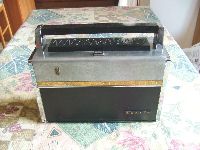 |
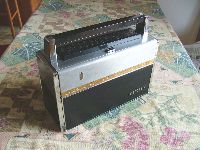 |
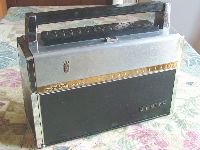 |
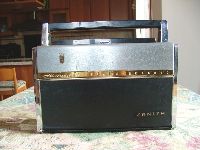 |
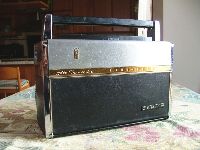 |
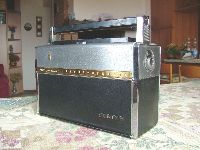 |
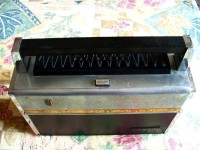 |
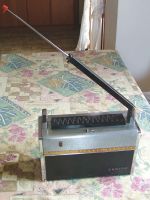 |
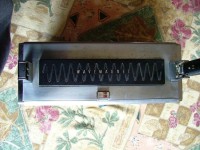 |
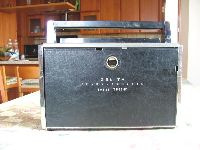 |
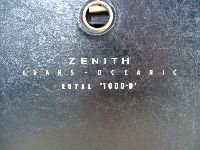 |
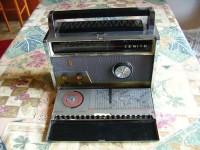 |
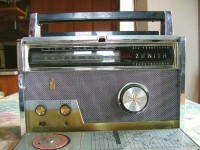 |
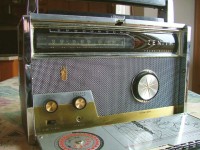 |
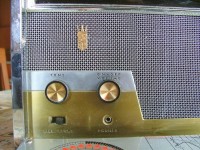 |
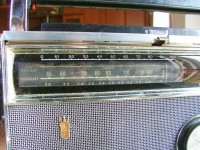 |
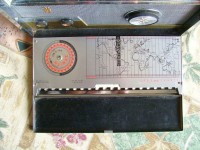 |
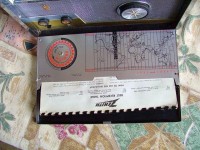 |
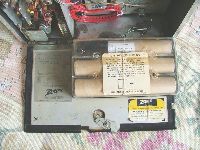 |
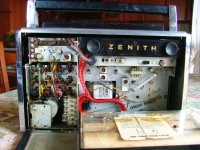 |
|
More images below
|
|||
|
La Royal 1000-D è stata la seconda Transoceanic che utilizzava i transistor come elementi attivi. La radio portatile era un sensibile ricevitore adatto all'ascolto della radiodiffusione e all'esplorazione delle Onde Corte. In totale la 1000-D poteva sintonizzare 9 bande di frequenza, una in più che nel precedente modello 1000. La Transoceanic 1000-D era una supereterodina che riceveva in Ampiezza Modulata le Onde Lunghe (da 200 a 400 KHz), le Onde Medie (da 540 a 1600 kHz) e sette bande di Onde Corte (da 2 a 22,5 MHz). Eccetto che per l'aggiunta degli avvolgimenti per le Onde Lunghe (la banda aggiunta al modello 1000-D), tutti i rimanenti circuiti erano gli stessi usati nel modello 1000. La selezione delle varie gamme avveniva tramite la rotazione del tamburo con le nove scale parlanti che era coassiale a un commutatore multiplo che selezionava di volta in volta uno dei nove circuiti di sintonia. Lo schema utilizzava nove transistor Zenith o RCA al germanio (vedi tabella equivalenze) tutti montati su zoccolo: 121-44, 124-49, 121-49, 121-73, 121-74, 121-64, 121-46, 121-47, 121-47 e una singola conversione di frequenza a 455 kHz. L'antenna a stilo per le Onde Corte era collocata all'interno della maniglia per il trasporto, un'antenna magnetica (wawemagnet) per Onde Medie e Lunghe era situata sulla parte superiore del mobile, mentre un'altra antenna wavemagnet staccabile e munita di ventose per uso in auto o in casa era collocata all'interno del mobile. Inoltre, aprendo il pannello posteriore della radio, nella parte in alto a sinistra dello chassis si poteva collegare una eventuale antenna filare esterna a una morsettiera marcata G e A (Ground and Antenna). L'uscita audio della 1000-D era di 500 mW a tutto volume, ma il suono riprodotto dall'altoparlante magnetico da 10 cm era caldo e piacevole. Nella parte interna del coperchio metallico frontale c'era una tasca dov'era collocato un libretto con le tabelle delle frequenze e gli orari delle stazioni (copia del libretto è in questo link), sempre sul coperchio anteriore c'era un disco rotante per il calcolo del fuso orario con a lato la relativa tabella dei fusi orari mondiali. Sul pannello frontale erano collocate le manopole per i controlli di sintonia, tono e on-off- volume. Un pulsante a slitta permetteva di accendere momentaneamente la luce della scala parlante. L'alimentazione della 1000-D era a batterie: 9 x 1.5Vcc. (tipo D o LR20); 8 batterie in serie fornivano 12 Vcc per la radio e un elemento da 1,5 Vcc era per la luce della scala. Il mobile era in metallo cromato con finiture in pelle; le dimensioni erano: 32 x 26 x 14 cm e il peso di circa 6,1 kg con le batterie.
Nota storica sulla guerra
fredda: © IK3HIA 2005. |
|||
|
|
|||
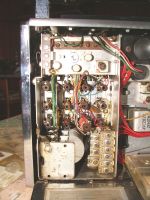 |
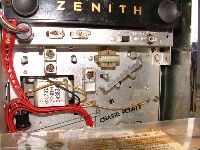 |
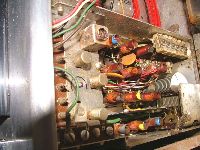 |
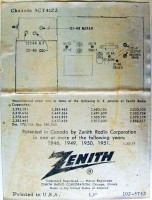 |
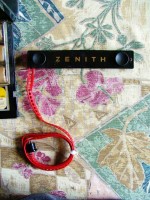 |
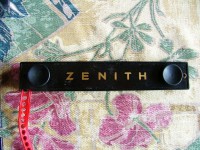 |
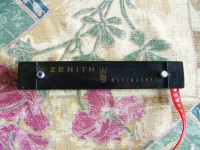 |
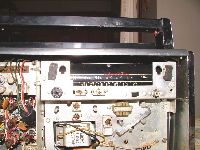 |
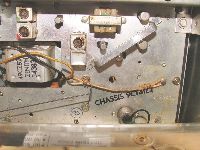 |
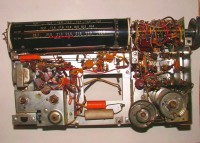 |
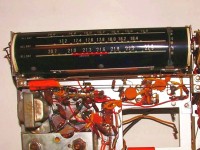 |
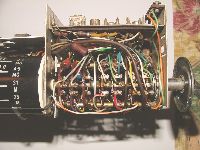 |
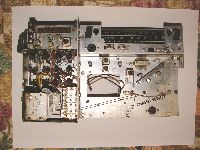 |
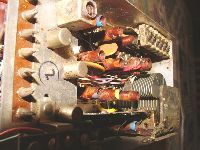 |
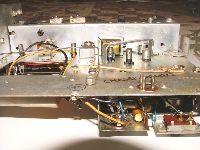 |
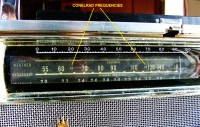 |
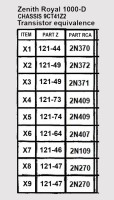 |
 |
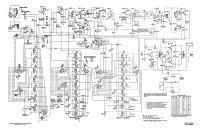 |
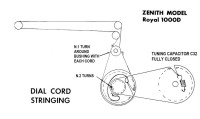 |
|
Return to top of
page
|
|||
| Back to: |
|
IK3HIA home page |
|
Zenith Radio page |
|
Transistor Radio page |
|
Transistor diagrams |